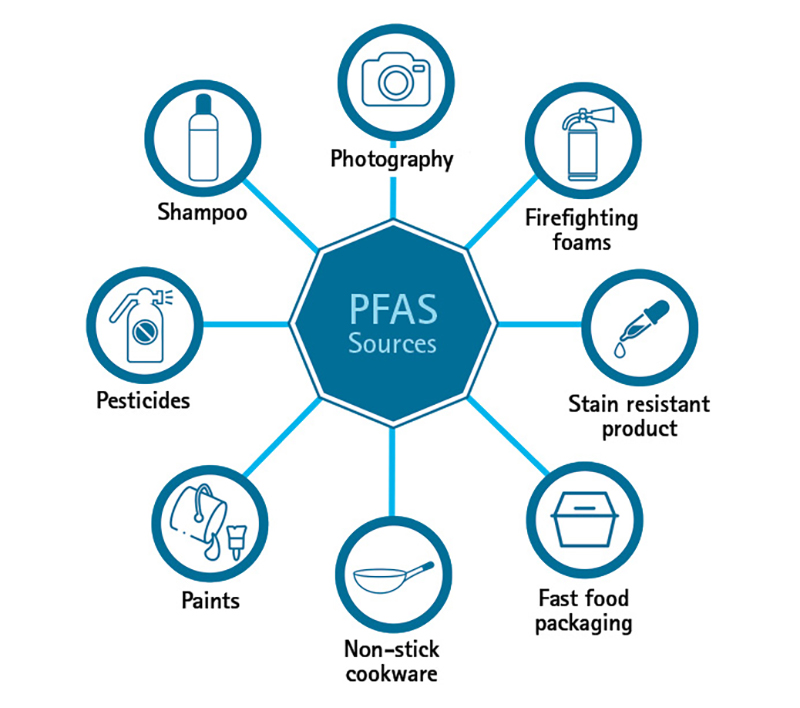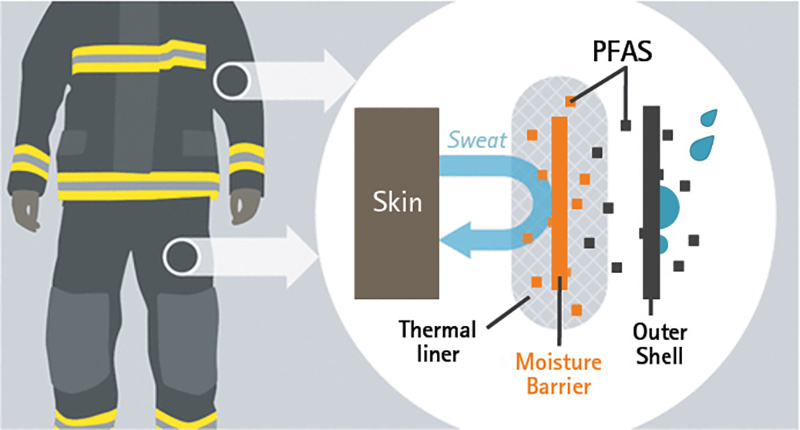BY BRIAN CRIMMINS
Certain protocols can effectively minimize a firefighter’s exposure to harmful per- and polyfluoroalkyl substances (PFAS) chemicals. In recent years, organizations from the International Association Fire Fighters (IAFF) to the Environmental Protection Agency (EPA) have issued advisory messages warning firefighters about a previously unrecognized hazard. The warnings state that PFAS chemical compounds had been used for decades to manufacture both firefighting turnout gear and aqueous film forming foam (AFFF). Today, firefighters across the world are still exposed to PFAS and experience an accumulation of these chemicals in their bloodstreams. PFAS exposure can lead to a variety of ailments including cancer, heart disease, and reproductive dysfunction. Armed with knowledge of PFAS, fire departments can now adopt the protocols outlined here to create a safer and healthier work environment.
- Humpday Hangout: Research Update on ‘Forever Chemicals’
- Researcher Responds to Claims About PFAS, Firefighter PPE
- It’s Time for Firefighters to Demand PFAS-Free PPE
- Your Gear, Your Life: Firefighter PPE Toxins and What to Do About Them
According to the Centers for Disease Control (CDC), PFAS chemicals often have great water-repellent and temperature-resistance qualities that are useful for manufacturing certain products from nonstick pans to firefighting turnout gear. PFAS are a group of approximately 9,000 synthetic chemicals consisting of chains of carbon atoms surrounded by fluorine atoms. They include perfluorooctanoic acid and perfluorooctanesulfonic acid. These compounds accumulate indefinitely in the bloodstream and in the environment, leading to their nickname “forever chemicals.”
The risk of PFAS exposure is alarming; there is evidence that PFAS can cause cancer and heart disease. Equally alarming is the research that PFAS causes a reduction in penis size, testicle size, and sperm count in men and a drop in fertility among women. As of June 2022, the EPA issued a public advisory in preparation for formal regulations. Studies now show that 97 percent of Americans have PFAS in their blood, and in firefighters, PFAS levels are greater than in the general population.
AFFF and Turnouts
Firefighter exposure to PFAS results, in part, from the use of AFFF. For decades, AFFF was the best tool to suppress Class B fires, particularly those involving petroleum products. Although fire departments have mostly phased out AFFF in recent years, research demonstrates that its PFAS ingredients have seeped into the soil and contaminated water supplies that feed humans, wildlife, and livestock. Additionally, there is concern that PFAS from Class B foam can be absorbed through firefighters’ skin and into their bloodstreams.
Figure 1. PFAS Compounds Uses

PFAS compounds have been used for a variety of industrial and commercial applications, including AFFF. Source: St. Mary’s County (MD) Health Department, http://www.smchd.org/pfas/.
The second PFAS exposure is the use of turnout gear that has been manufactured with PFAS-coated textiles. A 2020 study by the University of Notre Dame confirmed that firefighter personal protective equipment (PPE) poses a viable source of PFAS exposure. This study examined used and unused turnout gear from six manufacturers and identified high levels of PFAS in all areas. The researchers noted that the risk of firefighter exposure can come from inhaling contaminated dust particles shed from turnout gear, absorbing PFAS through the skin, and accidentally ingesting particles when firefighters touch food with contaminated hands.
Protocols
Given this knowledge, fire departments must take aim at reducing PFAS exposure. Examining the research at hand, it is possible to identify targeted lifestyle and workplace changes that can improve firefighter health, wellness, and performance. The following 10 steps are simple, straightforward, and easy to implement:
1. Dispose of all legacy AFFF foam in an environmentally friendly manner. Alternative suppressants for Class B fires that do not contain PFAS are available, such as fluorine-free foam or F3. Firefighters should not use legacy foam during training or emergencies and should never intentionally release legacy foam into the sewer.
2. Clean and maintain PPE per manufacturer specification and per National Fire Protection Association 1851, Standard on Selection, Care, and Maintenance of Protective Ensembles for Structural Fire Fighting and Proximity Fire Fighting. Turnout gear degrades over time, leaving dust that is laden with PFAS and that poses an inhalation hazard. Routine cleaning can remove contaminated dust.
3. Prohibit firefighting PPE in firehouse living quarters. Turnout gear can shed contamination with a host of harmful and carcinogenic chemicals, including PFAS and petroleum products.
4. Maintain a clean firehouse with routine cleaning. Make it a priority to wipe down surfaces, dust, and vacuum living quarters and areas where equipment and PPE are stored.
5. Wash station wear uniforms separately from personal clothing and firefighting PPE to avoid cross-contamination.
6. Practice rigorous personal hygiene in the firehouse. Wash hands diligently after touching PPE and take showers after fires and at the end of shifts.
7. Manage firehouse indoor air quality with natural ventilation and HEPA filtration. Ventilation is especially important when cleaning and vacuuming firehouses since dust particles tend to be aerosolized and can easily be inhaled.
8. Replace outdated turnout gear that has exceeded its life expectancy or has been damage beyond repair. New turnout gear should be manufactured without the use of PFAS chemicals.
9. Speak to your doctor if you are concerned about any work-related illness. Blood tests are available to measure PFAS levels. If you do not have a work-related illness and are still concerned about the possibility of PFAS accumulation in your blood, at-home test kits are available online.
10. Think before you select PPE.
Turnout gear is mandatory for firefighting and training but may not be appropriate for medical calls and other nonfire emergencies. Reduced overall use of turnout gear will reduce PFAS exposure.
Figure 2. Turnouts and PFAS

For years, firefighting turnout gear was manufactured with PFAS. These forever chemicals end up in firefighter’s bloodstream at rates that exceed the general population. (Reprinted with permission from Environ. Sci. Technol. Lett. 2020, 7, 8, 594–599. Publication Date: June 23, 2020. https://doi.org/10.1021/acs.estlett.0c00410. Copyright 2020 American Chemical Society.)
Firefighters should follow the news for the latest research and developments related to PFAS exposure. For example, a recent study of 285 Australian firefighters determined that donating blood or plasma lowers PFAS levels. This news is surprising to the say the least, and additional research on this topic is likely. PFAS lawsuits are also working their way through the legal system. For example, firefighters in New York and Massachusetts have filed class action lawsuits for work-related illnesses. Massachusetts and Colorado have each filed suit against chemical manufacturers, alleging that they knowingly released chemicals that contaminated soil and water supplies. The implications of these and other lawsuits will certainly have ripple effects throughout the country.
The chemicals used to manufacture turnout gear and AFFF are being absorbed, ingested, and inhaled by firefighters at rates that exceed those of the general population. These PFAS forever chemicals are believed to cause cancer, heart disease, and reproductive dysfunction. Following the information and recommendations provided from the CDC, the EPA, and independent researchers is critical to take protective measures, such as the 10 protocols listed here.
References
Centers for Disease Control and Prevention. (2021, July 7). “Per- and polyfluoroalkyl substances (PFAS). ”Workplace Safety and Health Topics. Centers for Disease Control and Prevention. Retrieved July 11, 2022, from https://bit.ly/3DMA2uD.
Di Nisio, A, Sabovic, I, Valente, U, Tescari, S, Rocca, MS, Guidolin, D, Dall’Acqua, S, Acquasaliente, L, Pozzi, N, Plebani, M, Garolla, A, & Foresta, C. (2018). Endocrine disruption of androgenic activity by perfluoroalkyl substances: Clinical and experimental evidence. The Journal of Clinical Endocrinology & Metabolism, 104(4), 1259–1271. https://bit.ly/3UiA9DK.
Gasiorowski, R, Forbes, MK, Silver, G, Krastev, Y, Hamdorf, B, Lewis, B, Tisbury, M, Cole-Sinclair, M, Lanphear, BP, Klein, RA, Holmes, N, & Taylor, MP. (2022). Effect of plasma and blood donations on levels of perfluoroalkyl and polyfluoroalkyl substances in firefighters in Australia. JAMA Network Open, 5(4). https://bit.ly/3dikq71.
U.S. Senate Hearing 115-461. Hearing on “The Federal Role in the Toxic PFAS Chemical Crisis.” (2018). https://bit.ly/3Bqyd3H.
Peaslee, GF, Wilkinson, JT, McGuinness, SR, Tighe, M, Caterisano, N, Lee, S, Gonzales, A, Roddy, M, Mills, S, & Mitchell, K. (2020). Another pathway for firefighter exposure to per- and polyfluoroalkyl substances: Firefighter textiles. Environmental Science & Technology Letters, 7(8), 594–599. https://bit.ly/3xwHmqe.
Technical Fact Sheet: Drinking Water Health Advisories for Four PFAS (PFOA, PFOS, GenX chemicals, and PFBS). (2022, June). EPA 822-F-22-00. Retrieved July 2022, from https://bit.ly/3S00Nji.
BRIAN CRIMMINS is the chief of the Hoboken (NJ) Fire Department. He has a BA from Boston College and an MPA from John Jay College. He serves on the health and safety committee of the NJ Career Fire Chiefs Association.

